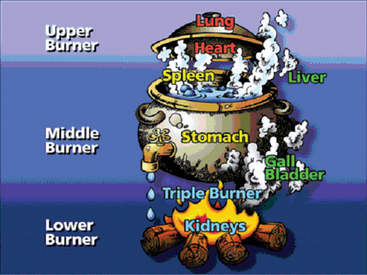CHAPTER 5 Overview of Traditional Chinese Medicine: The Cooking Pot Analogy
In Nei Jing Su Wen, the 2000-year-old seminal classic that gave rise to all of Chinese medicine, it is stated that to be a master physician, one must master the use of metaphors as they apply to medicine and the body. Perhaps the best metaphor for the inner workings of the body as understood by Chinese medicine is that of a cooking pot suspended over a fire (Figure 5-1).
THE BODY AS A COOKING POT
The Kidneys and Essence
The ability of Essence to be converted into a number of different substances in the body makes it similar in concept to cash in a savings account. Similar to cash, Essence can be spent in a number of ways, but all expenditures can roughly be classified as having a Yin or a Yang nature. Yang is roughly equivalent to energy, and Essence may be mobilized to create Yang energy that can then warm or generally animate the body. Yin, or substance, may be produced from Essence to combat certain wasting conditions, or to keep the body moist during extremes of heat. Although it allows the organism to meet the temporarily high demands for Yin and Yang produced by disease or climate extremes, the penalty associated with Essence consumption is a potential shortening of the life span of the organism.
The Bladder
Box 5-1 summarizes common symptoms of Kidney deficiency in small animals, as discussed earlier. Almost all symptoms are derived from a decline in body Essence, or Jing, over the life of the animal. It is not surprising, then, that these symptoms are also the most common signs of advancing age in both humans and animals.
The Spleen and the Stomach
Given its complete lack of any digestive function in conventional medical physiology, the labeling of the Spleen as a digestive organ is a source of discomfiture for many veterinarians who attempt to study Chinese medicine. The initial conjecture that the Spleen was a digestive organ was reasonable, however, given its obvious prominence in the human body in the exact location where digestion was quite literally felt to take place. The Spleen’s function was later determined as being filled by the pancreas; however, in humans, the pancreas is largely retroperitoneal and is almost indistinguishable from the adipose of the omentum, making it forgivable that the early Chinese did not identify it.
The Spleen is the source of not only healthful fluids but pathologic ones as well. When the Spleen and the Stomach lack the power to adequately transform food and water into useful substances, the material that is produced instead is known as Dampness or Phlegm. Dampness and Phlegm behave as normal fluids do to some extent, going where normal fluids go, such as into the joints, the mouth, and the bloodstream; then, they simply accumulate as a useless detritus that provides the foundation for some of the most serious and common small animal disorders. Sometimes, the pathologic fluid accretes into masses; at other times, it simply serves as a source of friction with circulating energy, which it releases uselessly as heat. In the mouth, Dampness and Phlegm can be directly visualized as tenacious saliva or, especially in humans, as a thick, greasy coating on the tongue surface. Manufacture of Dampness and Phlegm is prevented when the fire under the cooking pot is adequate, and when the pot itself is not overfilled (Boxes 5-2 and 5-3).
BOX 5-2 Common Signs of Dampness and Phlegm
| COMMON SIGNS OF SPLEEN DEFICIENCY | COMMON SIGNS OF STOMACH PATHOLOGY/DISEASE |
|---|---|
< div class='tao-gold-member'> Only gold members can continue reading. Log In or Register to continue
Stay updated, free articles. Join our Telegram channel
Full access? Get Clinical Tree
 Get Clinical Tree app for offline access
Get Clinical Tree app for offline access

|
